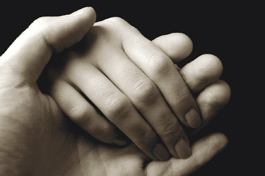home | north bay bohemian index | news | north bay | news article

EXTRA SET OF HANDS: Police chaplains volunteer to help support crime victims and other ordinary citizens who come into police contact for a variety of reasons.
There to Be There
Police chaplains ride the thin blue line of compassion
By Neal Ross Attinson
Spiritual practice and police work may seem an unlikely pairing, but for more than 50 volunteers with Sonoma County's Law Enforcement Chaplaincy Service (LECS), the combination is a way of life.
"I wanted to contribute in a way that included spiritual practice as a focus and center," explains Teresa Franklin, a registered nurse and graduate of last year's LECS academy. "One thing that surprised me is how closely I identified with the chaplaincy community, and also the work of law enforcement. I felt a kinship—like it was not a stretch to understand the personality type and loyalty toward serving the community that goes into those professions."
The interfaith, nondenominational agency, which begins its 11th training academy Sept. 23, describes its mission as one that provides solace and "emotional support" to law enforcement personnel and the community alike.
Officially, that mission includes acting as spiritual adjunct to Sonoma County's 18 emergency-response agencies by making death notifications and sitting with accident or crime victims—tasks which require an emotional depth that often receives short shrift in police training. In practice, says assistant senior chaplain BreeAnn Crespan, it also means doing what's needed for those having the worst day of their lives, "whether it's making phone calls, picking kids up from school, doing the dishes—we're there to be an extra set of hands, and a shoulder to cry upon if they need it. We are just there to be there."
Crespan acknowledges that there are those who may be reluctant to engage with someone whose job description includes any mention of God. But she stresses that the chaplain's job is primarily to listen—and never to convince.
"When people think 'chaplain,' there may be a stigma. People, in my experience, have automatically thought that means that we're going to proselytize," she says. "That's exactly the opposite of who we are. Our purpose is not to go in there and tell people our stories, but to be able to help them in an emotional way because we may know how they feel."
Franklin, who received her commission in April, was gratified that the need to serve others reached across lines of faith and into something universal.
"One thing that was a real pleasant reality was how diverse and interfaith it is; it doesn't require any particular religious affiliation," Franklin says. "In addition to having excellent leadership and really good peer support, I really felt like I was in excellent hands the whole time. We were given the skills and resources necessary to meet the challenges of the work."
Those skills and resources include an insider's view of police culture and procedures; tours of a funeral parlor and the county dispatch center, morgue and jail; familiarization with gangs, domestic violence and child abuse; and extensive role-playing and assessment, as well as the self-assessment necessary to avoid the burnout that can afflict all helping professionals. Candidates must go through a rigorous screening process before being admitted to the 28-week academy. Those who graduate are expected to commit to at least one year of being on 24-hour call twice a month and attending bimonthly in-service training.
Crespan says that while a chaplain candidate's basic qualifications are easy to state ("We're looking for someone who's compassionate, who's loving, who has good listening skills"), the decision to become a law-enforcement chaplain is less easily described.
"There are no words to explain it; you just know you're meant for it," she says.
Franklin agrees. "At first, my family and friends were saying, 'Why would you want to do that?'" she laughs. "And now they have a really deep sense of pride. They understand the work."
So does Franklin. She has so far participated in two "call-outs," or incident responses: one shortly before her April graduation, the other shortly after. One in particular illustrated for her that she had done the right thing.
"I had all of the uncertainty and anxiety of a newly commissioned chaplain," Franklin recalls, saying that one call-out concerned a man who had died in his mother's home. In this case, she was called to sit with the man's mother and 15-year-old daughter.
"The body needed to be removed, and that's not the kind of thing that a mother wants to witness," Franklin says. "Naturally, my fear was that I wouldn't know what to do. But I was so well trained to use my intuition and skills that the next decisions seemed to come naturally.
"The feeling I had after spending two and a half hours with that mother and adolescent girl—I walked out and said to myself, 'I did something good today.'"
The Law Enforcement Chaplaincy Service begins its 11th annual training academy on Sept. 23. For more information, including how to apply, visit www.sonomalawchaplains.org.
Send a letter to the editor about this story.
|
|
|
|
|
|